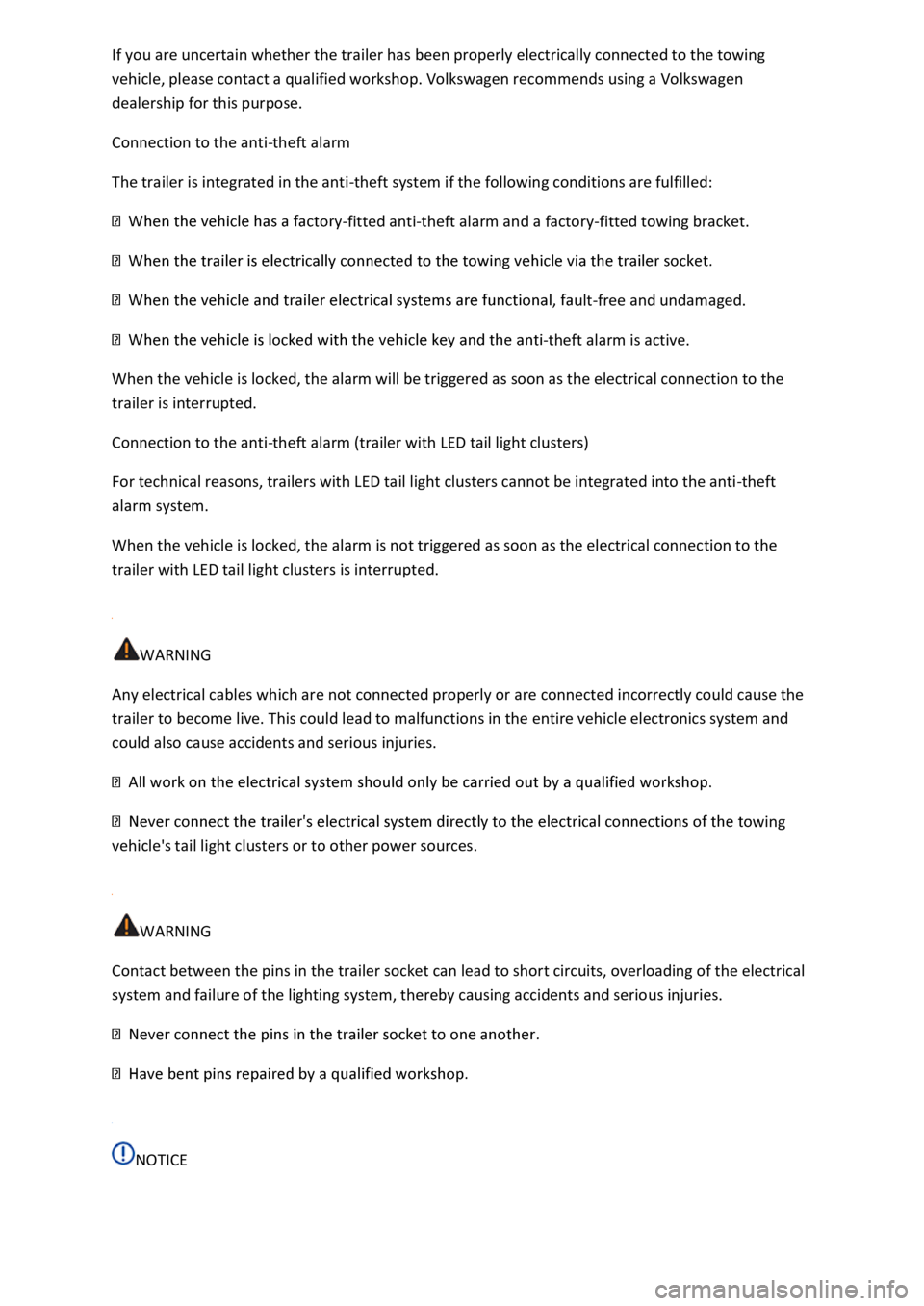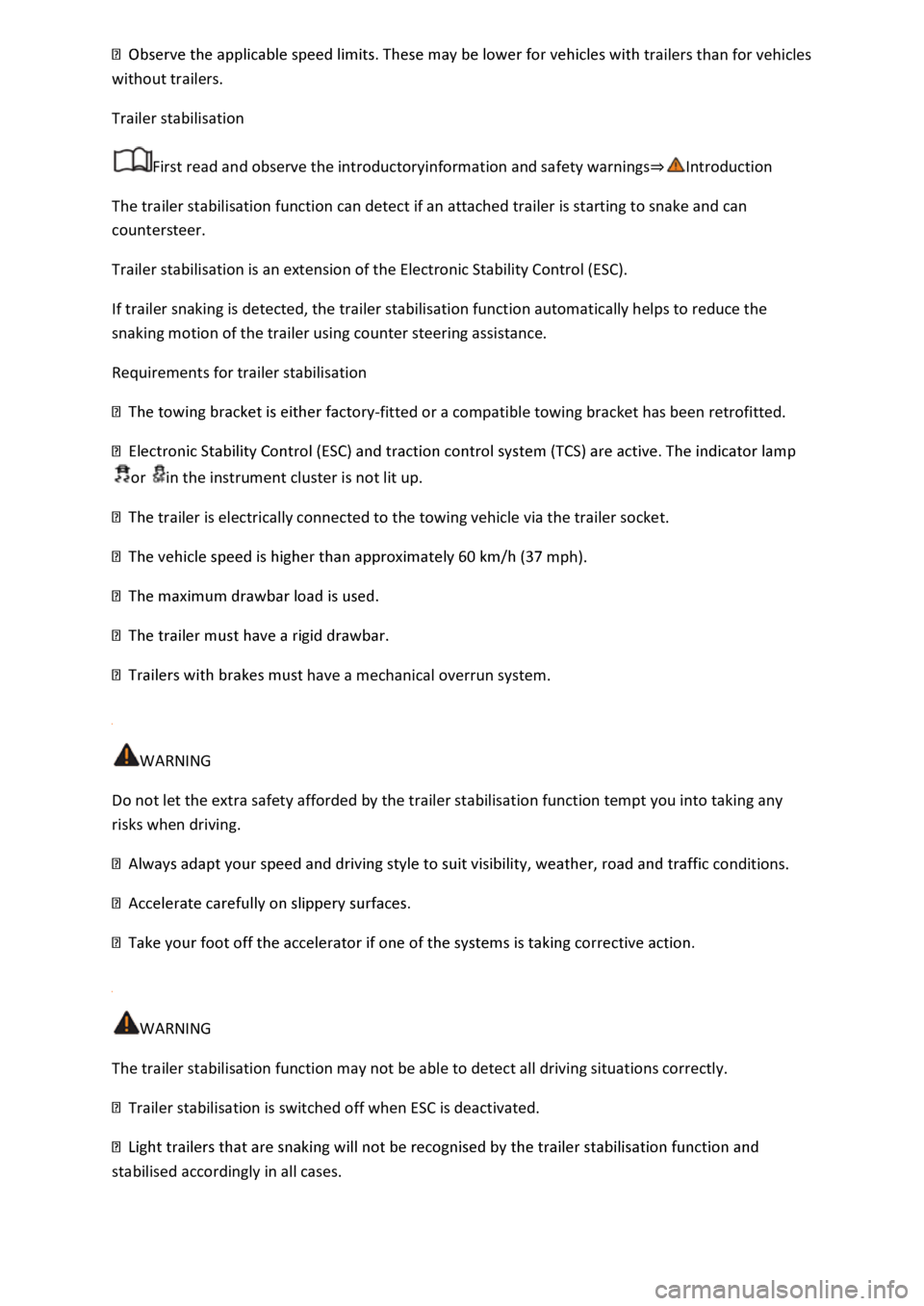Page 316 of 502

vehicle, please contact a qualified workshop. Volkswagen recommends using a Volkswagen
dealership for this purpose.
Connection to the anti-theft alarm
The trailer is integrated in the anti-theft system if the following conditions are fulfilled:
-fitted anti-theft alarm and a factory-fitted towing bracket.
ult-free and undamaged.
-theft alarm is active.
When the vehicle is locked, the alarm will be triggered as soon as the electrical connection to the
trailer is interrupted.
Connection to the anti-theft alarm (trailer with LED tail light clusters)
For technical reasons, trailers with LED tail light clusters cannot be integrated into the anti-theft
alarm system.
When the vehicle is locked, the alarm is not triggered as soon as the electrical connection to the
trailer with LED tail light clusters is interrupted.
WARNING
Any electrical cables which are not connected properly or are connected incorrectly could cause the
trailer to become live. This could lead to malfunctions in the entire vehicle electronics system and
could also cause accidents and serious injuries.
wing
vehicle's tail light clusters or to other power sources.
WARNING
Contact between the pins in the trailer socket can lead to short circuits, overloading of the electrical
system and failure of the lighting system, thereby causing accidents and serious injuries.
NOTICE
Page 317 of 502

unhitched from the vehicle. The vehicle could move up and down if the load changes or if there is
damage to the tyres, for example. If this happens, a great deal of force will be exerted on the towing
bracket and trailer, which could lead to damage to the vehicle and trailer.
If there is a fault in the vehicle or trailer electrical systems or in the anti-theft alarm, have the vehicle
checked by a qualified workshop.
If the 12-volt vehicle battery charge level is low, the electrical connection to the trailer will be
interrupted automatically.
Loading the trailer
First read and observe the introductoryinformation and safety warnings
Trailer weight and drawbar load
The trailer weight is the weight that the vehicle can pull
The drawbar load is the load that is exerted vertically from above onto the ball head of the towing
bracket.
The figures for trailer weights and drawbar weights that are given on the data plate of the towing
bracket are for certification purposes only. The correct values for your specific model, which may be
lower than these figures, are given in the vehicle registration documents. All data in the official
vehicle documents take precedence over these data.
The maximum permitted drawbar load exerted by the trailer drawbar on the ball head of the towing
bracket must not exceed 80 kg.
In the interest of driving safety, Volkswagen recommends that you always use the maximum
drawbar load. The handling of the vehicle combination will be impaired if the drawbar load is too
low.
The drawbar load increases the weight on the rear axle and reduces the maximum payload of the
vehicle as a result.
Gross combination weight
The gross combination weight is made up of the actual weight of the loaded vehicle and of the
loaded trailer.
In some countries, trailers are divided into different classes. Volkswagen recommends that you
contact a qualified workshop to find out about suitable trailers.
Loading the trailer
The weight of the load should be distributed evenly. The maximum permitted drawbar load should
be utilised. Do not place the load only at the front or the rear of the trailer:
Page 318 of 502

Tyre pressure
Follow the trailer manufacturer's recommendations concerning the tyre pressure for the trailer
tyres.
When towing a trailer, inflate the wheels on the towing vehicle with the maximum permitted tyre
pressure Tyre pressure
WARNING
Accidents and serious injuries can occur if you exceed the vehicle's maximum permitted gross axle
weight rating, drawbar load, gross vehicle weight rating or gross combination weight rating.
exceed the permissible gross vehicle weight for the vehicle with weight at the front and rear of the
vehicle.
WARNING
Loads that may slide can severely impair stability and driving safety, which can cause accidents and
severe injuries.
secure loads using suitable and undamaged lashing, retaining or securing straps.
Driving with a trailer
First read and observe the introductoryinformation and safety warnings
Headlight adjustment
Towing a trailer can raise the front end of the vehicle enough for the dipped beam to dazzle other
road users. Use the headlight range control to lower the light cone as required. Vehicles with
dynamic headlight range control are adjusted automatically.
Things to note when driving with a trailer
If the trailer has an overrun brake, apply the brakes gently at first and then firmly. This will
prevent the jerking that can be caused by the trailer wheels locking.
Page 319 of 502
prior to downhill gradients (manual gearbox or Tiptronic mode of the
automatic gearbox) to additionally make use of engine braking. The brake system could otherwise
overheat and fail.
will change because of the
trailer load and the increased combined towing weight of the vehicle and trailer.
When driving with this combination, drive particularly carefully and slowly.
Pulling off on slopes when towing a trailer
Depending on the steepness of the uphill gradient and the total weight of the trailer and vehicle, a
vehicle towing a trailer could roll back a short distance when moving off on a hill.
When towing a trailer, pull off on slopes as follows:
once to switch off the electronic parking brake Electronic parking brake
ly.
Manual gearbox: selecting a gearor selector lever position D/SDSG
Page 320 of 502

without trailers.
Trailer stabilisation
First read and observe the introductoryinformation and safety warnings
The trailer stabilisation function can detect if an attached trailer is starting to snake and can
countersteer.
Trailer stabilisation is an extension of the Electronic Stability Control (ESC).
If trailer snaking is detected, the trailer stabilisation function automatically helps to reduce the
snaking motion of the trailer using counter steering assistance.
Requirements for trailer stabilisation
-fitted or a compatible towing bracket has been retrofitted.
or in the instrument cluster is not lit up.
trailer is electrically connected to the towing vehicle via the trailer socket.
mph).
have a mechanical overrun system.
WARNING
Do not let the extra safety afforded by the trailer stabilisation function tempt you into taking any
risks when driving.
conditions.
WARNING
The trailer stabilisation function may not be able to detect all driving situations correctly.
Trailer stabilisation is switched off when ESC is deactivated.
stabilised accordingly in all cases.
Page 321 of 502
knife on slippery roads with little grip even if the towing vehicle is equipped
with trailer stabilisation.
er
socket is being used without a trailer (e.g. for a bicycle carrier with lighting).
Retrofitting a towing bracket
Fig. 157 Dimensions and mounting points for retrofitting a towing bracket.
First read and observe the introductoryinformation and safety warnings
Volkswagen recommends having the towing bracket retrofitted by a qualified workshop. The cooling
system may need to be modified or heat shields may need to be fitted. Volkswagen recommends
using a Volkswagen dealership for this purpose.
Dimensions
The dimensions Fig. 157must be observed in all cases when retrofitting a towing bracket. Always
observe the minimum distance given from the middle of the ball head to the surface of the road.
This also applies when the vehicle is fully laden, including maximum drawbar load.
Page 322 of 502
879 mm
at least 65 mm
350 420 mm
334 mm
554 mm
1,017 mm
1,051 mm
WARNING
Electrical cables that are not connected properly or are connected incorrectly can cause faults in the
entire vehicle electronics system and also cause accidents and serious injuries.
clusters or to other unsuitable power sources. Use only suitable connectors for connection of the
trailer.
WARNING
The trailer can become detached from the towing vehicle if the towing bracket is unsuitable or
incorrectly fitted. This can cause serious accidents and fatal injuries.
Use only towing brackets which have been approved by Volkswagen for your vehicle type.
Fuel and emission control
Safety notes on handling fuel
WARNING
Incorrect handling of fuel can cause explosions, fire, serious burns and other injuries.
Switching the auxiliary heater and ventilation on and
off
Page 323 of 502
WARNING
Filling the tank with the wrong fuel can damage the vehicle.
uels that have been approved for the vehicle.
-approved service additives in the
approved quantity.
CAUTION
Fuel may run out of a fuel canister. This could cause fire and injuries.
Fuels can pollute the environment. Collect any service fluids that escape or are spilled and dispose of
them correctly.
The tank flap cannot be opened manually. Seek expert assistance in an emergency.
Fuel types and refuelling
Introduction
This chapter contains information on the followingsubjects:
Fuel standards
Petrol
Diesel
The tank flap is located at the rear right-hand side of the vehicle.
Different engines require different fuels. There is a factory-fitted sticker in the tank flap that
indicates the required fuel type for the vehicle.